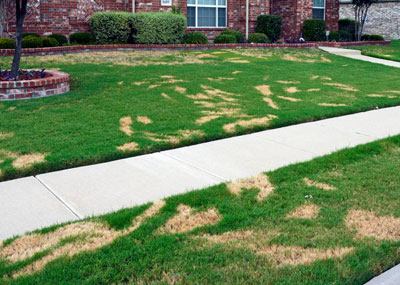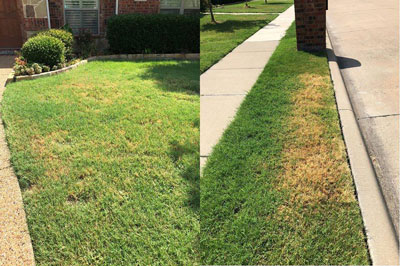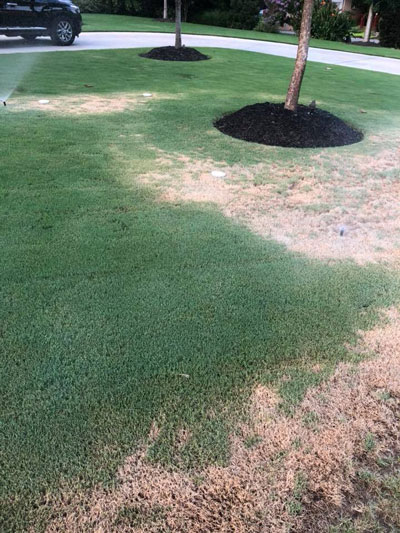Question of the Week Number 2: July 19, 2018
“What is causing my bermuda to turn brown in these unusual patterns? I know I’m watering it properly.”

Pythium disease patterns in infected lawn are unlike any other.
This disease and I go back almost 50 years for me. When Lynn and I moved to Dallas in September 1970 I took the position as Dallas County Extension Horticulturist. My office for the first year was in the Records Building, across the street from the Texas School Book Depository. I had an east-facing office on the top floor. I looked down on beautiful hybrid bermuda the city had planted in a downtown park.
One Monday morning I came in, and it looked like someone had heaved balloons filled with boiling hot water down onto the grass. It looked scalded in elongated browned patches. I contacted pathologists with Texas A&M. They came downtown to look and told me it was cottony blight, a late summer disease caused by the water mold fungus Pythium.

These are from two areas of the same lawn. Photos posted to my Facebook page last week.
Factors that favor Pythium invasion…
• Warm, humid weather,
• Heavy, poorly draining soils,
• Evening waterings,
• Mowing with contaminated equipment, and
• Pythium infections nearby.

Another photo posted to my Facebook page in the past few days shows Pythium’s distinct and dramatically sharp lines of attack. Someone challenged me on my diagnosis, but watching this disease for 48 years and seeing it lay down strong lines like you see in the other photos here, I told him I was completely comfortable with my diagnosis. The only thing unusual this time around is that it’s showing up 4-6 weeks earlier than usual.
Texas A&M tells us that fungicides are not always helpful, but that addressing the bulleted list above however best that you can will help. Here is information from TAMU that you may find useful.
A few parting comments…
Many people are condemning St. Augustine because of its several problems (take all root rot, chinch bugs, gray leaf spot, brown patch, etc.).
As we grow bermudagrass turf across entire cities, it, too, is likely to develop widespread issues. Pythium is certainly capable of being one of them. I’ve seen more of it this summer already than I usually do at this time. And we had several cases of take all root rot identified by pathologists in bermuda lawns this spring.
Zoysia has had its name called a few times as well. So as I’ve said a few times before, we don’t have a perfect turfgrass just yet.
